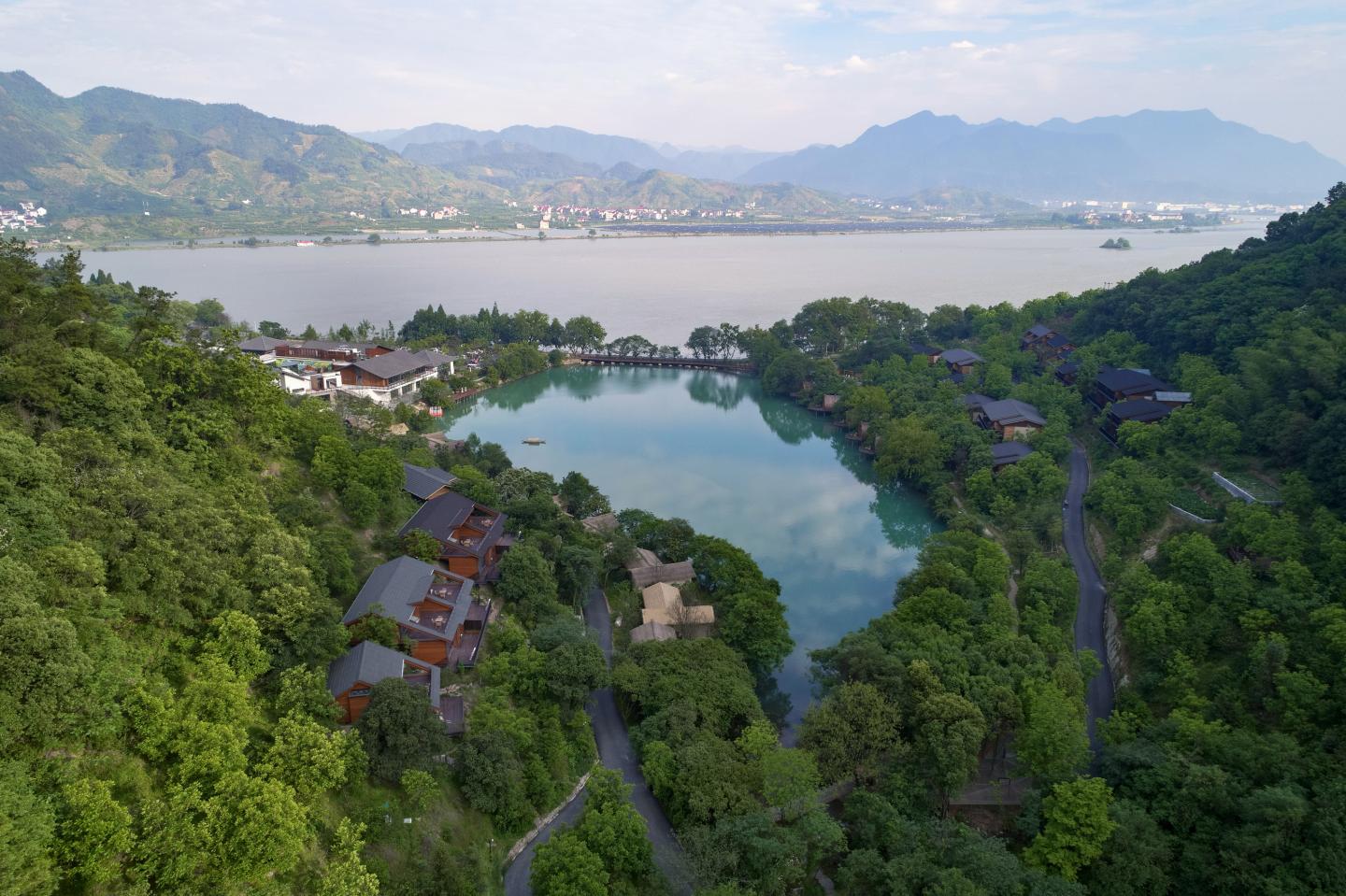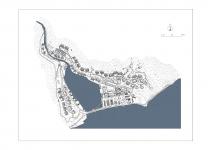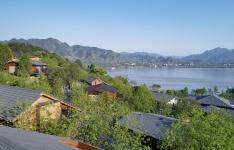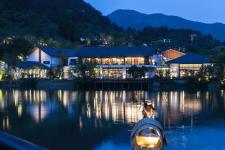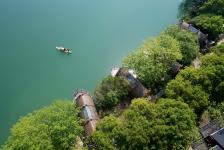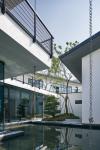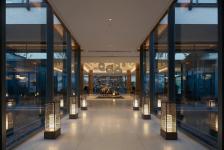Background and Site Condition
A famous Chinese Yuan Dynasty painting known as "Dwelling in the Fuchun Mountains" describes a beautiful living scene along Fuchun River. The target of the project is to build a resort of housing area of 20,000sq.M. and make it act as an engine in developing local tourism and playing positive role in countryside revitalization.
The site of this project is located in Wushi shoal, ancient town of Meicheng, Jiande City and is adjacent with Fuchin River. It is in triangle shape with specific natural resources inside. The land is formed by alluvial deposit from the Mountains and the central lake comes from water connection. The rich natural resources and beautiful scene of Lake, stream, woodland within over 13ha site area, as well as Fuchin River constitute an extreme beautiful moving picture. This part is also the most open area along Fuchin River. Doing project in this kind of site condition, it is beyond of building houses, or designing a hotel, instead it becomes a conversation between the designers and complex topography and environment.
Master Planning
The first important duty for the designers is to do site investigation. Driving northwards of 6km from the ancient town of Meicheng along Fuchun River, “We are completely immersed in a picturesque surrounding” the designers said. “This site condition is of great advantage however taking consideration of diverse and complex site elevation variation and soil and hydrology characteristics, it becomes very sensitive and to be of great challenge for us to do site planning and architecture design on it.”
An overall judgment and site plan generate after over 10 times site investigation. A lake of 20,000sq.M. is determined to be the focus of the site. Flat place east to the lake is supposed to be as the main entrance of the resort. The original old dorms and office building of former forestry station need to be removed and a main building covering 8,000sq.M. will be built on the place of them. Small flat area in between the west, north sides of the central lake and along the ravine stream is ideal place for setting guest rooms approaching to the water. And in the hilly area with different slopes in the site, there are plenty of orchards such as arbutus, pecan, and orange trees. Looking down from the hill, the scene turns to be open facing to the southern Fuchun River. Over 500 existing old trees (over 20cm DBH) are scattered in the construction site. All of these elements give particular site identity to the guest rooms no matter where they are built.
In transportation, one main loop plays the role in connecting accessibility to the main building and some guest rooms on the flat area. The loop turns to be cut into two parts when it arrives in western flat area. Moving through the forest adjacent to the waterfronts where boat rooms exist, pedestrian pathway is set to access this small-sized cluster. The visitors may feel their every step leading to a quiet and peaceful place where they will live in before arriving the boat rooms. Another part of the road is set going through guest rooms in gently sloping mountains, which is also convenient for afterwards construction operation and property management. Where the loop cannot continue in steep mountain area in the north of central lake, secondary roads with less than 8% slope are built. These roads are set to be adjacent with the rooms to minimize construction impacts to environment while fulfilling fire safety requirement. And stairs and pathways are paved to guide visitors arriving at rest rooms within 30m distances. Within this walking distance, the guests may enjoy the interesting wildness on the way.
Diversity in Architecture Structure and Style
Due to complex site condition and difficulty for large-scale construction equipment accessibility in the mountain area, different architecture structures are applied for different sites. Such as in flat place, traditional reinforced concrete structure are built by manpower digging hole piles. And reinforced timber structure on steel platform is employed for boat rooms that are floating on the west bank of the lake and do represent boating-living culture of an ancient water tribe named “nine fishing families”. The application of various building structure aims to engage the new-built architecture with local environment to the maximum extent while minimizing environmental impact.
It is expected to avoid big abrupt or boring architecture styles and camp-style arrangement in this project. Respecting local building culture and keeping some connectivity in between different single building and building cluster are the wise and reasonable choice. More than 10 guest room modules are built. They are scattered hiding in the mountain trees and naturally immersed with local environment. The design and construction of main building respect Huizhou building style and its painting keeps with white walls in color preference. The texture of white wall is specially treated which looks like waving ripple of Fuchun River. Villa in the riverside with imitated rammed earth thatched cottage style reveals common architecture style of Zhejiang dwelling house. And cladding panel made by Red Cedar or Spruce is used to decorate guest rooms in mountain to keep consistence with their surrounding existences. Color adjustment of the cladding panel for different guest rooms gives various identities to the buildings, and avoids feelings of strangeness possibly produced by color uniform. However, no matter in which kind of room modules, the uniformed large viewing windows and grand viewing terraces facilitate guests to find out nice pictures outsides. The mountains, streams, lakes, rivers, old trees, together with the scattering guest rooms are re-organized into a new landscape.
Low Impact Construction Measures
The designers believe, the process of site planning and architecture design is a continuing dialogue with the site, and their target in this case is try to blur the boundary between architecture and environment. Protection of the local ecological environment is always put in the priority during the site development.
In the process of destroying and re-protecting, some key principals are applied:
1. The design of vehicle route follows the original topography that minimizes construction intervention and earthwork quantity. This is achieved by frequent level measurement of the architectures and the mountain roads. And the location of the main loop plays crucial role in transportation construction afterwards.
2. The stilts are built on steep mountains. Independent house foundation is built, on which fabricated light steel is constructed. This architecture structure not only reduces earthwork quantity production but also benefits of protecting local geological setting and plant resource.
3. Trees are evaluated as the first priority and the building plan is deleted or revised to another place.
4. Soils and stones produced in the road construction are reused for building retaining wall along the road or to be pavement materials, which not only recycle construction materials but also largely reduces transportation cost, cuts material budget and accomplish low impact construction on site.
5. Artificial micro-ecological filters are utilized for wastewater treatment. The system continues to collect and pipeline transfer sewage to anaerobic reactor decompose, where large organics is decomposed into small molecules that can be easily absorbed through the filter. Then the pre-treated wastewater is pumped intermittently to the micro-ecological filter for further treatment. The final filtrated water then enters into a pool before being pumped to be recycled for landscaping and car washing. The application of three circulated filter systems eliminate sewage discharge to Fuchun River and meanwhile create natural landscape with aquatic plants on their surfaces.
Some Details Treatment
As damp weather in mountains, the rooms are designed to escape humidity in structure treatment. For guest rooms in steel framework, concrete pillars with 10cm high are built below steel tubes, which is to cut off corrosion due to connection between steel tubes and damp soil. As for the main building and guest rooms in concrete framework, the basic floor is upraised and a cavity floor is useful for ventilation as well as moisture protection. The cavity wall treatment is also copied for rooms with walls near the mountain body.
Instead of municipal pipe network in city area in terms of stormwater management, in this project the designers do not apply compulsory drainage system but to draw rainwater in tunnels to the lake and streams as it does naturally. Meanwhile, downpipes are reduced in architecture, and rain chain is introduced for decoration while leading rainwater onto the ground for infiltration.
The boat room is a very special guest room cluster in this project and the concept and shape of the “boat room” are inspired from a local social custom, a water tribe which is named as “nine fishing families” that had resided at the riverside and created a unique culture of boat-living life for several hundred years. The design keeps the standing culture and does consideration of site condition as well as habitant comfortability. By adopting modern heavy timber structural system, the design logic and simplified decoration reveal the structural aesthetics and spatial force of the boat room. Together with the particular beauty of curved Wupeng Boat in the land of fish and rice of South China, the boat room creates a poetic dwelling space for the visitors “to see the blue water that is limpid than the sky and to experience to fall asleep in a rainfall night in a beautiful painted boat”. The design of boat room thus becomes a highlight in this project.
Conclusion
Rational and logical site planning and architecture design that based on scientific and detailed site investigation are applied to deal with the relationship between construction and environment protection in this project. Wherever the visitors are, the landscape elements such as elaborate buildings, trees, river and streams, sunset glow, moon, lake surface turn to be a great picture. The beautiful scenes in this modern drawing of “Dwelling in the Fuchun Mountains” attract visitors to open the poetic scroll in this countryside holiday resort.
2016
2018
Site Area: 13ha
Housing Area: 20,000m2
Design Period: 2016.06-2016.12
Construction Period: 2016.12-2018.01
Completion time: 2018.01
Architect’ Firm: The Design Institute Of Landscape & Architecture China Academy Of Art CO.LTD.
Website: http://www.caaladi.com/
Client: New Century Tourism Group
Lead Architects: Xiawei Chen, Lijun Ke
Architects: Tuo Jin, Kai Wang, Guangjie Yu, Jianzheng Zhou
Consultant of Wood Structure: Suyi Guo, China Modern Wood Structure Construction Technology Industry Alliance
Interior Designers: PANTIANSHOU Landscape, Design&Planning, CO.,LTD.
Photo credits: Aoguan Performance of Architecture
